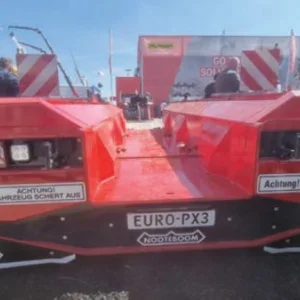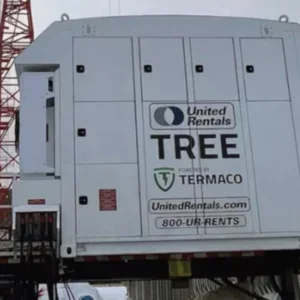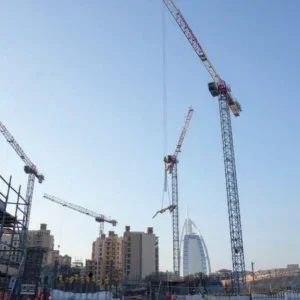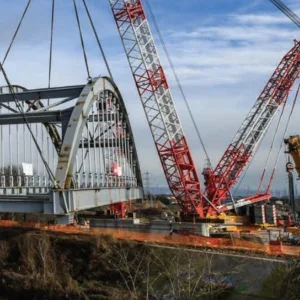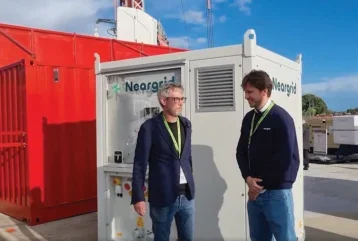
It’s over a year now since UN global environmental authority United Nations Environment Programme (UNEP) deemed the building and construction sector as the largest emitter of greenhouse gases, accounting for 37% of global emissions.
During the same timeframe we have also seen rapid development in the energy storage systems sector. Portable electrical systems, basically big batteries, that can power cranes are becoming big business.
It’s easy to see why… construction companies looking to embrace a more sustainable future can make considerable gains by powering their cranes by batteries.
CO2 SAVINGS
Spearheading this list of gains is CO2 savings. And manufacturers of these battery systems are keen to highlight this.
Singapore-headquartered battery energy storage specialist Ampd Energy, for example, claims use of its systems can reduce carbon footprints by up to 90%.
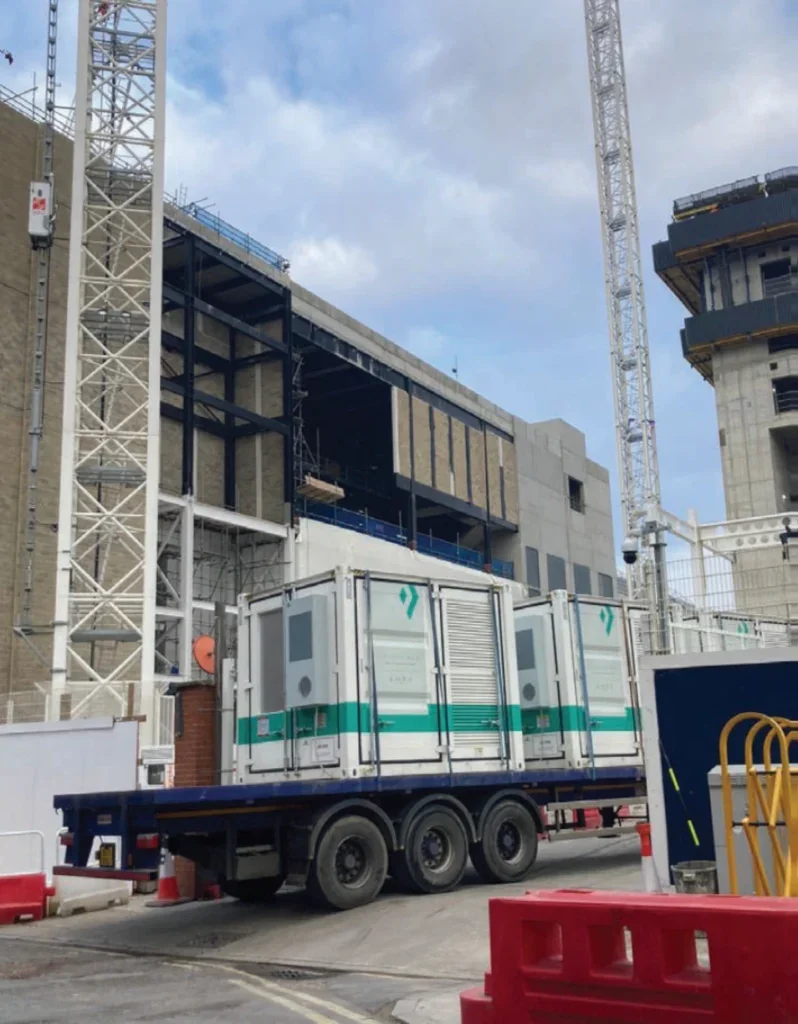
It points to specific examples as evidence. It calculates that one client, UK construction and development group Bowmer + Kirkland, for example, prevented 461 tonnes of CO2 by using just one of its Enertainer systems on the Goods Yard project, Stoke-on- Trent, UK, between March ’23 to April ’24.
Since it founded in 2014 Ampd Energy says it has deployed more than 300 units among seven countries, primarily in construction, and as a result claims to have abated over 69,000 tonnes of CO2 which, it says, is the equivalent to removing over 88,000 cars from the road.
Clients include Far Easternbased construction companies, as you would expect from a Singapore-based company, such as Sino Group, Woh Hup, Chun Wo Development Holdings, Kimly Construction and SOCAM Development, plus, more recently, western firms including Select Plant Hire, Compass Equipment, and the Torsion Group.
Ampd’s two flagship products are the aforementioned Enertainer (a fusion of the words energy and container), and the smaller, scalable mobile power solution, Ampd Silo.
SIZE WISE
Aside from CO2 savings batteries provide other advantages.
In terms of size the Enertainer is just 2.6 metres square, and weights just 7.3 tonnes. This means it is manoeuvrable on the job site.
Steven Parsonage, senior site manager at Bowmer + Kirkland’s Goods Yard project identifies some of the advantages of this with regards to eliminating diesel handling and usage risks on the Stoke job.
“At the Goods Yard site there’s a 200-year-old basement under two thirds of it, so we had two tower cranes – one on either side of the basement. This, however, meant that getting fuel over to the generator would have been a nogo as we couldn’t track that sort of weight over the basement vaults. We looked at other alternatives, such as running cables through the site, but we decided to go with the battery instead which has worked really well.”
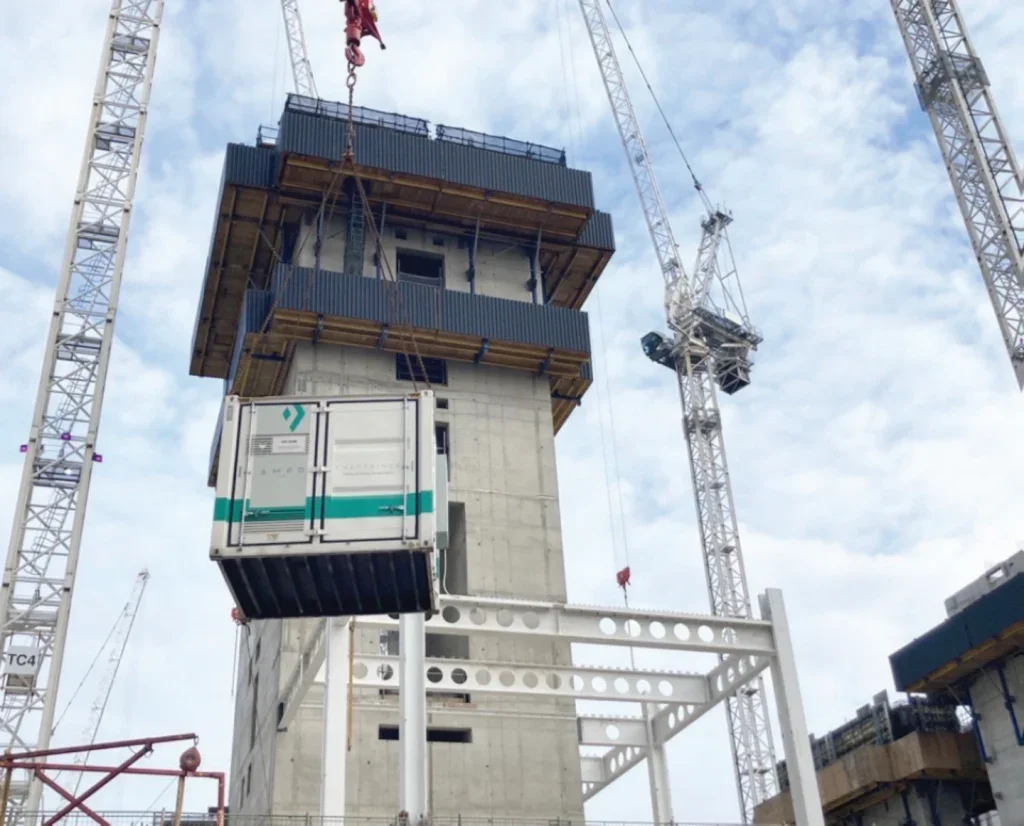
The unit was rented through Select Plant Hire and was connected to the main grid – only requiring 28 amps throughout the whole duration of the project whilst powering the equivalent of 100kVA of tower cranes.
Parsonage identifies other advantages: “It’s neat and tidy and sits well on the job. It’s incredibly quiet, so there were no problems with noise.”
Indeed, Apmd claims use of its energy storage systems reduces noise by nearly 32 times compared to a diesel generator, enabling work to continue overnight in residential areas, if required.
Another area of benefit Parsonage speaks about came when the Stoke site’s main electrics got knocked out by a water leak. “Because of the battery we could continue working whilst the site’s electrics we being fixed.”
Indeed, points out Parsonage, it’s not often a site has a ready supply of electric from start to finish. “It’s very rare, these days, that you have the luxury of a permanent power source on your project from early – but the system was exactly that. We plugged our tower cranes into the energy source and off they went. There was no need for fuel deliveries and no generator services to interrupt the work-flow. The battery was reliable with no issues at all.”
There are further reasons, Ampd says, as to why its Enertainer is a more desirable option compared to diesel generators. First, it’s driven by software. Ampd claims this means every Enertainer gets better over time through software updates that effect new features, capabilities and performance.
The system also has a modular architecture, enabling flexibility via multiple levels of redundancy. It remains, however, instantly familiar to any trained electrician, meaning transitioning a site to Enertainer power is straightforward, Ampd claims.
The Enertainer has been designed to comply with stringent international standards and has logged over 1,500,000 hours of incident free operation to date.
Finally, the unit can be remotely monitored thanks to its WiFi connectivity.
ATTRACTING INVESTMENT
It’s not just construction companies that have been taking note of Ampd and its offerings; investors have, too.
At the start of November Apmd Energy announced that it has raised $27.3 million in an oversubscribed Series B funding. The round was co-led by Kibo Invest and Openspace, the largest investor, with notable participation from existing investors MTR Lab, Taronga Ventures and 2150 who, Ampd says, are participating above pro-rata.
The funds will be used to further expand decarbonisation across new verticals and regions, including the mining and manufacturing markets in 2025.
Proceeds will also go toward targeting new geographies including the Middle East, Europe, United States and Southeast Asia, Apmd adds.
“This new funding is a testament to the hard work of our team, our focus on being a commercially viable cleaner solution for businesses around the world, and the commitment from our investors in creating an emission-free future for industries,” said Anthony Stewart, CFO at Ampd Energy. ‘We’re looking ahead to accelerating our growth, entering new verticals and delivering even more innovative solutions to our customers globally.”
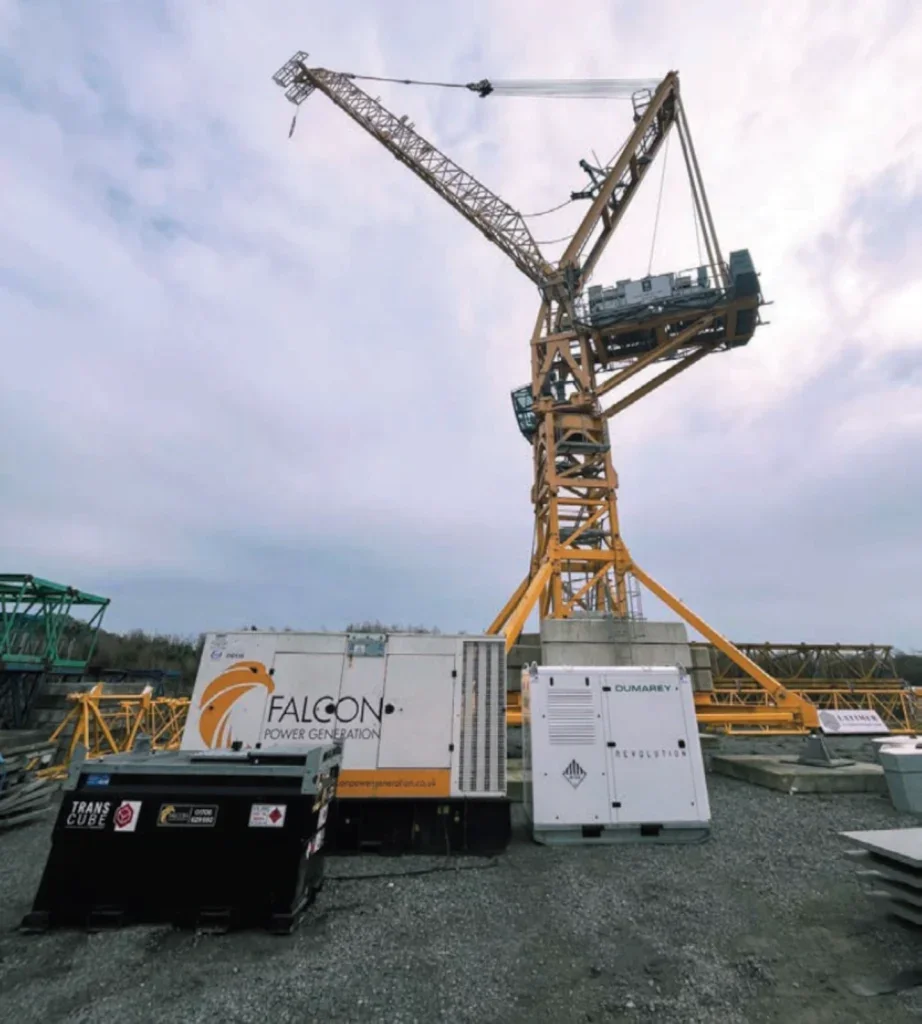
GOING GREEN
UK energy storage systems specialist Dumarey Green Power is also enjoying success. The company, formerly known as Punch Flybrid, was founded in 2007 to make flywheels for Formula One motorsport applications. The technology, however, did not really become utilised in the F1 sector as much as Punch Flybrid had hoped.
As a result the company diversified, retooling its flywheel towards use as an industrial product. It rebranded to Dumarey in Jan 2024 and then, following the acquisition of a battery storage company in The Netherlands, became Dumarey Green Power.
Dumarey Green Power has a range of different products for construction applications comprising flywheel energy systems and battery storage systems.
“The batteries have a number of uses depending on which ones we’re talking about,” explains Alex Keys, sales and marketing director at Dumarey Green Power. “Our latest battery product Revolution, for example, is aimed at highly dynamic equipment such as cranes and hoists.
“A lot of batteries out there need a lot of storage to create high power. That makes those systems very large; it also makes them big on site. The Revolution battery, however, uses a 1:1 power to energy ratio where it is able to create 300 kW from just 28 kW hours of battery storage. This means the system is much more compact, it’s a better use of natural resources, and it makes it more cost effective.
“We use lithium-ion batteries, along with large three-phase drives, in our own battery packs which are built at our facility in Silverstone,” says Keys. “This means we’re able to push these batteries to high peaks for a short duration.”
The first five units are being made this year and they’ve been purchased by UK company Falcon Tower Cranes in a deal that was inked in September.
Since then the Revolution Battery system has successfully completed trials with Falcon Tower Cranes. The high-power battery was deployed on a Jaso J80pa luffing jib tower crane and a J160 saddle jib crane – both individually and with simultaneous lifts and multiple active motions.
The system was then transferred to a large J380pa luffing jib crane, which recorded peak power demand of over 200 kW.
The team from Falcon was trained to commission the system, and tested a variety of modes and functionality including utilising a Falcon Power Generation generator to charge the battery.
Andy Brown managing director at Falcon Tower Crane Services commented, “We are excited to deepen our partnership with Dumarey Green Power through the adoption of their ground-breaking Revolution battery.
At Falcon, we have always been committed to leveraging the most innovative technologies to reduce our environmental impact and deliver sustainable solutions to our clients. The collaboration marks a significant step in our efforts to further reduce our reliance on traditional diesel generators and move towards a cleaner, more energy-efficient future.
The Revolutions Battery’s ability to provide high peak power with minimal energy storage aligns perfectly with our operational needs and environmental goals.”
CHARGING AHEAD
Lokeren, Belgium-based battery company Neargrid Solutions is also enjoying rapid progress in a short space of time. Since opening in 2020 the company says it has sold over 80 of its battery units which have been used to power over 200 tower cranes.
The company quickly identified that construction sites often need electric power exceeding the capacity of the available electric distribution grid connection points. Tower cranes, in particular, require very high peak currents when a load is hoisted, it says. This poses a problem that traditionally has been solved by implementing heavy diesel generators to deliver the peak currents; Neargrid says its two flagship battery products, the Force and Boost, offer an ecoalternative that can help reduce the operating costs of powering tower cranes on site.
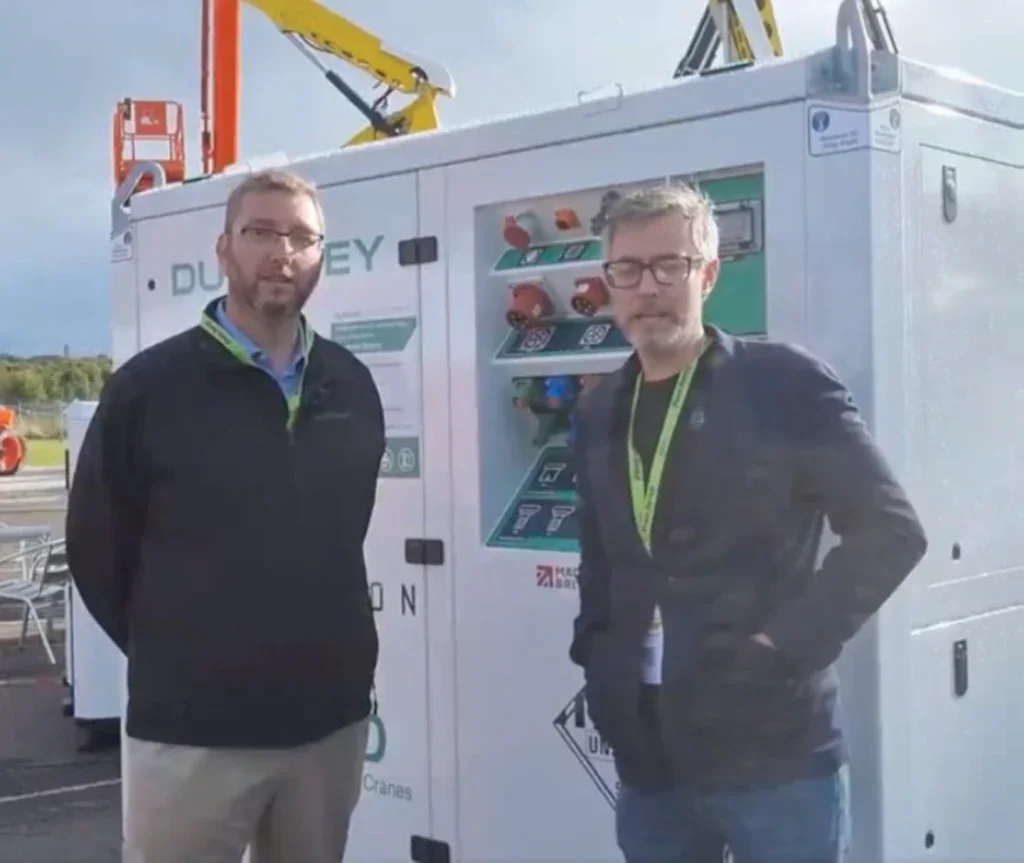
Neargrid places its systems between the distribution grid and the site consumers: an easy obtainable low-voltage residential connection is sufficient to charge the battery on a permanent basis. The battery/inverter then meets the fluctuating power demand from the construction site.
The Force, the biggest in the portfolio, can be used to supply up to three heavy tower cranes, plus other small equipment. The Boost can supply one tower crane. Furthermore, the battery system is fitted with a comprehensive energy monitoring system that is designed to give a thorough insight into energy consumption on site.
“Our batteries are currently serving a variety of tower cranes,” says Gil De Backer, business development manager speaking at Vertikal Days 2024 trade show in the UK in September. “The batteries can be charged using a low voltage grid connection or, if that’s not yet available, even via a small diesel gen set.
“We are experienced with supplying power to flat-top and high-top tower cranes, particularly in Belgium and the Netherlands. We’re also gaining experience with luffing jib cranes.”
Vertikal Days was the first time for Neargrid exhibiting in the UK. “We are looking for distributors and rental companies in the UK to take them into their portfolio and rent them out to the UK market,” explains De Backer. And we had some really interesting conversations that I hope we will see results from…”

So, with demand only set to increase, the future looks bright for these dynamic pioneers of portable power for cranes.
Neargrid has just expanded its range to include the Compact – with a capacity of 45kVA and a battery capacity of 60kWh. “It’s our smallest unit suitable for construction sites with smaller cranes – such as self-erectors,” De Backer explains.
Neargrid envisions that in the transition to using fully powered renewable energy systems bottlenecks in the electricity grid will inevitably appear.
As a result, it believes it is wellplaced to meet demand. Dedicated battery solutions will be needed to facilitate the deployment of new electric consumers in the journey towards a fully renewable energy system, it says.
In the UK Bowmer and Kirkland has invested in another of Ampd Energy’s Enertainer systems, this time for its southern branch.
Ampd has also enjoyed the support of Select Plant Hire subsidiary Laing O’Rourke which, at the start of 2024, successfully deployed three of its Enertainer lithium-ion battery energy storage systems to London’s Olympia Redevelopment.
Northampton based contractor Winvic Construction is also a supporter – using the Enertainer to power a Potain MR 225 luffing jib tower crane supplied by Radius Group on the Crown Place jobsite in Birmingham (more on this jobsite to come in the next issue)
And at Ampd’s headquarters its management team is already considering which new markets in which to increase its presence thanks to its latest funding win.
The crane battery sector is on an upward trajectory, driven by the construction industry’s urgent need to decarbonise and adopt sustainable solutions. Innovative battery technologies are not only addressing environmental challenges but also providing practical benefits like compact designs, reduced noise, and operational reliability. These advances reflect the sector’s response to mounting pressures for greener construction practices, and the success stories of clients underscore the tangible impact these systems are having on CO2 reduction and site efficiency.
The backing from investors and the global expansion plans of these companies demonstrate the confidence in batterypowered solutions as the future of construction energy needs. As the industry transitions towards renewable energy systems these technologies promise to play a critical role in overcoming grid limitations and paving the way for sustainable progress.
In this dynamic environment collaboration rather than competition is shaping the market fostering a positive outlook for the future of clean, portable power in construction.
SELECT PARTNERS WITH ZENOBĒ TO ADVANCE SUSTAINABLE POWER SOLUTIONS
Select has partnered with energy storage specialist Zenobē to help provide clean power for construction sites by utilising second-life batteries (refurbished electric bus batteries) and transforming them into portable batteries.
Select is being supplied with 20 portable batteries from Zenobē to be used as temporary power sources that run as a cleaner alternative to diesel generators. One battery unit can store approximately 150kwh of energy and can also connect with the local grid to provide power across a variety of applications including construction, lifting solutions, and electric vehicle charging.
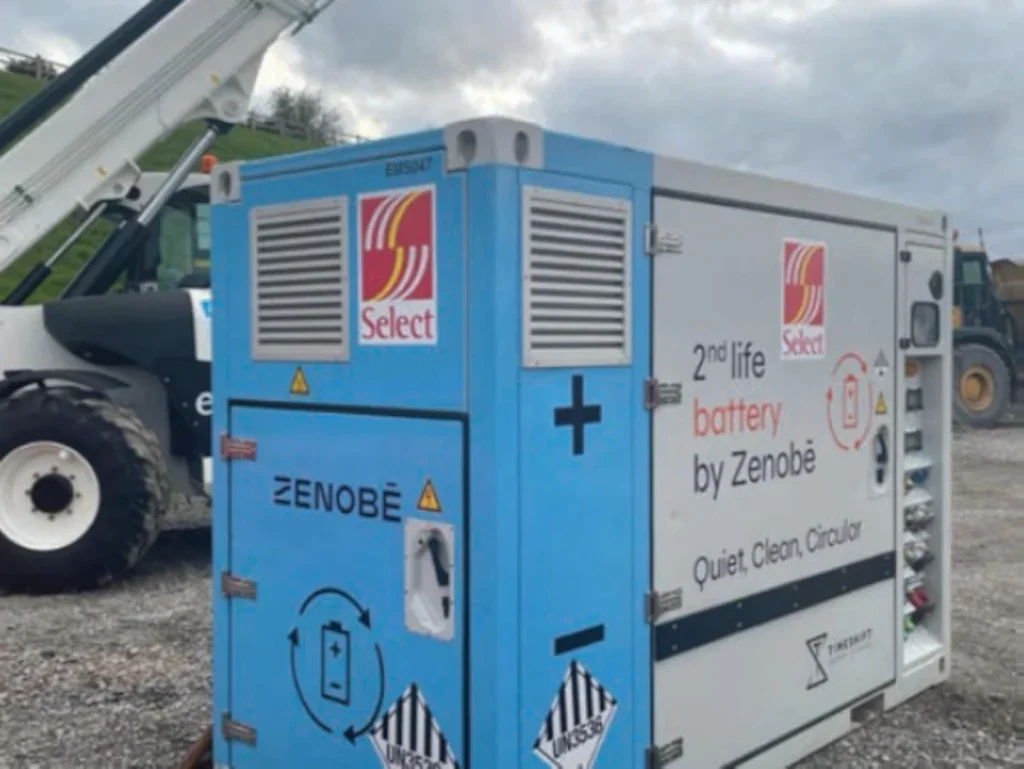
Select says its collaboration with Zenobē marks a milestone in advancing its business and aligning with its corporate sustainability strategy, which pledges to achieve operational net zero by 2030.
Select’s product lead, Ian Fleming, says “Our collaboration with Zenobē represents another pivotal moment in our journey to redefining the future of energy storage in the construction industry. It emphasises Select’s commitment to innovation, sustainability solutions and resilience, setting a new standard for the industry and empowering a cleaner, more reliable construction landscape.”
Zenobē’s co-founder director, Steven Meersman, says “Our portable batteries, made from refurbished electric bus batteries, provide Select Power with a ready and proven solution for their customers to decarbonise their projects. Our flexible funding and technical support provide the technological and sustainability benefits without the need of ownership. Having already been used in the film, events, and logistics industries to much success, we are looking forward to seeing them becoming a regular sight, providing clean and reliable power to construction projects around the country.”


